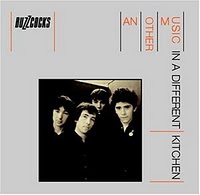 There are some albums which will never age and remain relevant no matter what the prevailing musical trends; Another Music In A Different Kitchen is one such album. Many predicted the demise of the band following the departure of founder member Howard DeVoto but this magnificent album proved the doom-mongers wrong. The Buzzcocks’ magnum opus is not punk but brash rock and roll with pop overtones couched in the candid language of the day. It carries no pretensions and refuses to acknowledge any inspirational influences. This is simply four blokes having a good time. From the buzz-saw introduction of early single “Boredom” which both opens and closes the album but doesn’t actually appear in its entirety, this is a quite breathtaking selection of songs but, in my opinion, side two is where all the nuggets are to be found. The brilliant jagged guitar that ranges throughout “Fiction Romance”, the driving bass/guitar that punctuates the chorus of “Autonomy”, the desperate, manic vocals which feature on “I Need” and the devastating drumming which rolls through “Moving Along With The Pulsebeat” and is one of the few occasions a drum solo can claim to be more than window dressing – all important considerations when understanding what makes this type of music so powerful. A true classic of the punk era without being a punk album. –Ian
There are some albums which will never age and remain relevant no matter what the prevailing musical trends; Another Music In A Different Kitchen is one such album. Many predicted the demise of the band following the departure of founder member Howard DeVoto but this magnificent album proved the doom-mongers wrong. The Buzzcocks’ magnum opus is not punk but brash rock and roll with pop overtones couched in the candid language of the day. It carries no pretensions and refuses to acknowledge any inspirational influences. This is simply four blokes having a good time. From the buzz-saw introduction of early single “Boredom” which both opens and closes the album but doesn’t actually appear in its entirety, this is a quite breathtaking selection of songs but, in my opinion, side two is where all the nuggets are to be found. The brilliant jagged guitar that ranges throughout “Fiction Romance”, the driving bass/guitar that punctuates the chorus of “Autonomy”, the desperate, manic vocals which feature on “I Need” and the devastating drumming which rolls through “Moving Along With The Pulsebeat” and is one of the few occasions a drum solo can claim to be more than window dressing – all important considerations when understanding what makes this type of music so powerful. A true classic of the punk era without being a punk album. –Ian
Album Reviews
Beyond the Gilded Palace:
A Guide to Country Rock’s Golden Age
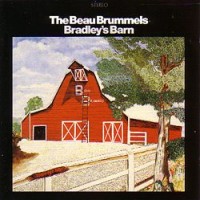
Even though early rock and roll was deeply rooted in country music, the two were ideologically at odds from the start. This rift became more pronounced as the ’50s gave way to the ’60s, and by 1965 Nashville was more provincial than ever, seemingly impervious to the supernovas of musical activity in cities like London and LA. Nevertheless, rumblings of a sea change can be heard during this time period even in the music of Rock’s prime movers, the Beatles’ “Run For Your Life” on Rubber Soul just one example.
In 1966, less than a year after he had almost been booed offstage for playing an electric guitar at the Newport Folk Festival, Bob Dylan would travel to Nashville to cut a little record called Blonde On Blonde. Similarly, even on their early albums the Byrds and Buffalo Springfield wore their country influences on their sleeves, this mark of distinction becoming even more pronounced with each release. Something needed to give, and give it eventually did in the summer of 1968. Embracing traditional country & western (some argue to a fault), the Byrd’s landmark LP Sweetheart of the Rodeo announced the arrival of a new aesthetic. Released the following spring, Bob Dylan’s downhome Nashville Skyline upped the ante even more.
These records confused both the squares and the hippies when they came out, but not as much as when Gram Parsons and Chris Hillman defected from the Byrds to form the Flying Burrito Brothers. Parsons, most largely responsible for the Byrd’s dramatic switch to Country purism on “Sweetheart…”, needed a broader sonic canvas to explore his “Cosmic American Music”, and he would do just that on 1969′s The Gilded Palace of Sin. Its cover, depicting the long-haired Parsons in a marijuana leaf-patterned rhinestone suit, conveyed its mission statement almost as much as the music within. Unlike the Byrds’ and Dylan’s albums, The Gilded Palace of Sin took pieces from country and rock and reassembled them into something truly unique. Of the three releases in this “Country Rock Holy Trinity”, the Burrito’s album sold the most poorly, but its long-term impact exceeded that of its counterparts. Immediately after its release, musicians of all stripes took notice, and decades later the alt. country movement would be born when bands such as Uncle Tupelo and the Jayhawks returned to this well with a similar M.O. But the few years between the late ’60s and early ’70s represent what can only be called Country Rock’s Golden Age. Below are some more highlights:
 1. Bradley’s Barn Beau Brummels (1968) This release by undervalued San Francisco folk rockers, which arrived in stores just a few short weeks after Sweetheart of the Rodeo, is in some ways more successful than its competition. Much of this can be attributed to Sal Valentino’s gritty vocals and the impeccable picking of some ace Nashville sessioneers.
1. Bradley’s Barn Beau Brummels (1968) This release by undervalued San Francisco folk rockers, which arrived in stores just a few short weeks after Sweetheart of the Rodeo, is in some ways more successful than its competition. Much of this can be attributed to Sal Valentino’s gritty vocals and the impeccable picking of some ace Nashville sessioneers.
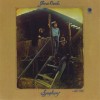 2. Goose Creek Symphony Established 1970 (1970) On their debut album, this Arizona outfit conveys a laid-back and goofy stoner vibe, which somewhat belies its virtuosic musicianship. Its side two opener, “Talk About Goose Creek and Other Important Places”, is one of country rock’s great psychedelic rave-ups.
2. Goose Creek Symphony Established 1970 (1970) On their debut album, this Arizona outfit conveys a laid-back and goofy stoner vibe, which somewhat belies its virtuosic musicianship. Its side two opener, “Talk About Goose Creek and Other Important Places”, is one of country rock’s great psychedelic rave-ups.
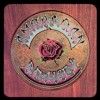 3. Grateful Dead American Beauty (1970) Which Grateful Dead album most typifies country rock is open to debate; clearly, it’s a toss-up between Workingman’s Dead and their next album, American Beauty. But in the end the latter achieves this distinction, if only by a slim margin. Featuring Jerry Garcia’s sparkling pedal steel guitar and some of the band’s best ever harmonies, the Dead would never sound this great in the studio again.
3. Grateful Dead American Beauty (1970) Which Grateful Dead album most typifies country rock is open to debate; clearly, it’s a toss-up between Workingman’s Dead and their next album, American Beauty. But in the end the latter achieves this distinction, if only by a slim margin. Featuring Jerry Garcia’s sparkling pedal steel guitar and some of the band’s best ever harmonies, the Dead would never sound this great in the studio again.
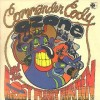 4. Commander Cody and His Lost Planet Airmen Lost in the Ozone (1971) Looking back almost as much as it looked forward, this raucous album introduced elements of rockabilly and boogie-woogie into the country rock mix. Commander Cody would record some more great albums, but this remains his definitive statement.
4. Commander Cody and His Lost Planet Airmen Lost in the Ozone (1971) Looking back almost as much as it looked forward, this raucous album introduced elements of rockabilly and boogie-woogie into the country rock mix. Commander Cody would record some more great albums, but this remains his definitive statement.
 5. Michael Nesmith And the Hits Just Keep on Comin’ (1972) The Monkees’ hippest member recorded some of the best music in the country rock canon. But this minimalist outing, which features a rendition of “Different Drum” that’s superior to Linda Ronstadt’s version, is a true standout.
5. Michael Nesmith And the Hits Just Keep on Comin’ (1972) The Monkees’ hippest member recorded some of the best music in the country rock canon. But this minimalist outing, which features a rendition of “Different Drum” that’s superior to Linda Ronstadt’s version, is a true standout.
Further listening: Across the pond, Americana made its mark in 60′s Britain as well. For an idea of what what Country sounds like when it’s melded with Yardbirdsy blues, check out The Country Sect by The Downliners Sect; its 1965 release date makes it a record that was truly ahead of its time. Ray Davies was also taking notes when it came to Country, and his obsessions with it are most successfully explored on the Kinks’ last great album, 1971′s Muswell Hillbillies. Brinsley Schwarz, a band that counted Nick Lowe as an original member, were major underachievers in their day, but their take on country would come to define another genre, pub rock. Their second LP, Despite it All, is a small masterpiece. – Richard P
Are we forgetting anyone? We’d love to hear your comments:
King Crimson “In the Court of the Crimson King” (1969)
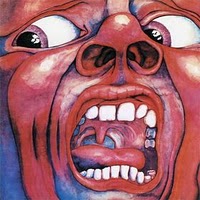 Released in progressive rock’s ground zero year of 1969, King Crimson’s debut instantly upped the ante in terms of expanding the possibilities of where rock music could go, it’s expansive songs and the individual members’ mastery of their instruments defining the genre. One seriously heavy and hyper-intelligent statement, In the Court of the Crimson King explodes with the primal, scalding venom of “21st Century Schizoid Man,” as lyricist Peter Sinfield’s Vietnam-era imagery of “innocents raped by napalm fire” delivered through Greg Lake’s distorted vocals are encircled by a torrent of lacerating Fripp guitar chords, tightly controlled high-octane ensemble passages, and free-jazz discord from Ian McDonald’s layered sax solo. “21st Century Schizoid Man” sets you up for an almost reverse-whiplash effect, as tracks like the exploratory “Moonchild” and lush chamber balladry of “I Talk to the Wind” widen the scope further with their fragility, while the stately “Epitaph” and bombastic title track are carried on the towering waves of a booming, primitive/modern mellotron orchestra, as images of doom and destruction abound. In the Court of the Crimson King would set the template for much of King Crimson’s work, despite the band’s multiple lineup changes, with it’s ability to bludgeon, soothe, and strike a nerve throughout this landmark release resulting in a distinguished rock institution. –Ben
Released in progressive rock’s ground zero year of 1969, King Crimson’s debut instantly upped the ante in terms of expanding the possibilities of where rock music could go, it’s expansive songs and the individual members’ mastery of their instruments defining the genre. One seriously heavy and hyper-intelligent statement, In the Court of the Crimson King explodes with the primal, scalding venom of “21st Century Schizoid Man,” as lyricist Peter Sinfield’s Vietnam-era imagery of “innocents raped by napalm fire” delivered through Greg Lake’s distorted vocals are encircled by a torrent of lacerating Fripp guitar chords, tightly controlled high-octane ensemble passages, and free-jazz discord from Ian McDonald’s layered sax solo. “21st Century Schizoid Man” sets you up for an almost reverse-whiplash effect, as tracks like the exploratory “Moonchild” and lush chamber balladry of “I Talk to the Wind” widen the scope further with their fragility, while the stately “Epitaph” and bombastic title track are carried on the towering waves of a booming, primitive/modern mellotron orchestra, as images of doom and destruction abound. In the Court of the Crimson King would set the template for much of King Crimson’s work, despite the band’s multiple lineup changes, with it’s ability to bludgeon, soothe, and strike a nerve throughout this landmark release resulting in a distinguished rock institution. –Ben
Miles Davis “Get Up With It” (1970)
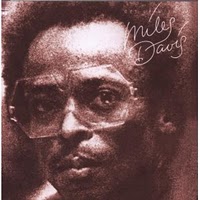 Without a doubt, one of the greatest albums of them all, a double set only comparable to the likes of the Stooges’ “Funhouse” in its darkness, intensity and raw, funky sexuality. Now for starters let’s get something straight: I loathe “fusion”, and to even CONSIDER putting Miles’ music of the ’70s in that category – a genre filled with lilly-livered chumps like Return To Forever and the Yellow Jackets – is a great disservice to Miles and his music. From 1969 to ’75, Mr. Davis pioneered and created his own unique sounds, a mixture of hard funk, psychedelic rock, avant-garde electronics and free jazz, that has never been equalled in regards to its sonics or its “vibe”. There is NOTHING that can touch the raised-middle-finger jab in the guts felt when one puts on discs like “Dark Magus”, “Live Evil”, “Agharta”, “Big Fun” or “On The Corner”. The feelings of utter loathing and despair, the overwhelming EMOTION of these discs can be too much, yet nothing can prepare you for 1974’s “Get Up With It”, a disc of such wildness and total lack of any commercial forethought (and thank the heavens for that) that it was granted pretty much instant deletion upon release and has mainly only been available from Japan for the last 25 years.
Without a doubt, one of the greatest albums of them all, a double set only comparable to the likes of the Stooges’ “Funhouse” in its darkness, intensity and raw, funky sexuality. Now for starters let’s get something straight: I loathe “fusion”, and to even CONSIDER putting Miles’ music of the ’70s in that category – a genre filled with lilly-livered chumps like Return To Forever and the Yellow Jackets – is a great disservice to Miles and his music. From 1969 to ’75, Mr. Davis pioneered and created his own unique sounds, a mixture of hard funk, psychedelic rock, avant-garde electronics and free jazz, that has never been equalled in regards to its sonics or its “vibe”. There is NOTHING that can touch the raised-middle-finger jab in the guts felt when one puts on discs like “Dark Magus”, “Live Evil”, “Agharta”, “Big Fun” or “On The Corner”. The feelings of utter loathing and despair, the overwhelming EMOTION of these discs can be too much, yet nothing can prepare you for 1974’s “Get Up With It”, a disc of such wildness and total lack of any commercial forethought (and thank the heavens for that) that it was granted pretty much instant deletion upon release and has mainly only been available from Japan for the last 25 years.
Start with the cover: a big, slightly unflattering, grainy photo of The Man. It’s the sight of a man against the world, battling for his own identity. Hit the first track, “He Loved Him Madly” (a tribute to Duke Ellington), a 32-minute ambient piece only broken up occasionally by Peter Cosey’s mumbling guitar lines. It’s one of the saddest damn songs you’ll ever hear, and you can bet yer booty that if it was made by a bunch of white guys in Berlin ca. ’71, every Krautrock freak in town would be hailing it as a classic. Next track “Maiysha” is a schizophrenic one. For ten minutes in merely putters along like a lite Latin number, interrupted sporadically by Miles’ Sun Ra-like organ, then it stops, gets into a hard groove and proceeds to move along to Peter Cosey’s awesome guitar screeches for another five minutes. Hot. “Honky Tonk” is up next, a brief interlude of stop-start rhythms and noisy organ crunch. It prepares you for the next track the unstoppable “Rated X”, THE peak of Miles’ – or maybe anyone’s – sonic capabilities. Part hyperdive breakbeat rhthyms, part uber-funk, and nine parts pure noise, there is no other sound on earth as MOVING as this song. Get up with it. Disc two starts with “Calypso Frelimo”, another 32-minute piece that starts where “Rated X” finishes off. Ecstatic peaks of dark psychedelic jamming, aided by Miles’ wah-wah’d trumpet, gel and compete. “Red China Blues” is a brief number that kicks it in a Chess-Records-meets-Ornette way, and the 15-minute+ “Mtume” once again takes you for a ride with its collision of Cosey’s guitar (a highly under-rated player in a field with the likes of Sonny Sharrock) and about half a dozen percussionists. Finishing is “Billy Preston”, more chilling mid-range avant-funk to close the set. “Get Up With It” is the perfect summation of what was filling Miles’ head at the time: the avant electronics of Stockhausen, the cyclical funk of James Brown, the wailing psych guitar of Hendrix, the improvised freeness of Ornette Coleman and as The Man himself put it, “a deep African thing”. Many words have been written on Miles’ music of this period, but to really GET it, you have to LISTEN to it. Not a word is spoken on GUWI, yet it speaks volumes on its creator’s alienation and sense of despair. As far as so-called “out-rock” goes, this is about as “out” as you could get, and certainly about as purely “psychedelic” as music has ever gotten, so do the done thing and get with it. –Dave
ZZ Top – Tejas (1977)
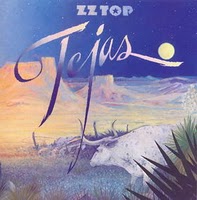 1977s Tejas is a transition album for Texas rockers ZZ Top. It is the beginning of their step away from the Blues Rock that had brought them fame and a lot of record sales and towards the 1980s Electronic Blues that would eventually make them a worldwide phenomenon. There is more of the former Blues Rock than the latter Electronica here though. Tejas is almost as good a ZZ Top’s masterpiece Deguello, but is held back by some weaker tracks, something Deguello didn’t suffer from. Still there are some amazing songs here, notable the blazing, yet tongue in cheek Arrested for Driving While Blind, the countrified and rollicking She’s a Heartbreaker, and the achingly beautiful Asleep in the Desert. Overall Tejas is an important part of ZZ Top’s discography, and a very good album. –Karl
1977s Tejas is a transition album for Texas rockers ZZ Top. It is the beginning of their step away from the Blues Rock that had brought them fame and a lot of record sales and towards the 1980s Electronic Blues that would eventually make them a worldwide phenomenon. There is more of the former Blues Rock than the latter Electronica here though. Tejas is almost as good a ZZ Top’s masterpiece Deguello, but is held back by some weaker tracks, something Deguello didn’t suffer from. Still there are some amazing songs here, notable the blazing, yet tongue in cheek Arrested for Driving While Blind, the countrified and rollicking She’s a Heartbreaker, and the achingly beautiful Asleep in the Desert. Overall Tejas is an important part of ZZ Top’s discography, and a very good album. –Karl
The Ventures “The Ventures Christmas Album” (1965)
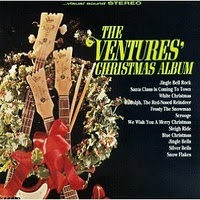 The Ventures, who seemed to crank out a dozen-odd albums every year during their heyday in the 1960s, released this gem in 1965. It distinguishes itself from its holiday brethren by using a mixture of two styles that should be antitheses of each other: the Christmas carol and surf music (or more fundamentally, winter and summer). Traditionally, the heart of each of these styles lies in evoking a mood. The danger in trying to evoke two moods simultaneously is that it might become a hokey mishmash (like those “Santa-in-a-Hawaiian-shirt” tourist trinkets for sale in the islands). Through the skill of The Ventures and their producers, however, the two are combined into a fairly seamless whole, both heartfelt and fun – a pretty nifty trick. As on their other surf records, the guitar tones of Don Wilson and Nokie Edwards are still king, but sleigh bells (more or less subbing for the hi-hat) and glockenspiel challenge for supremacy in the mix. This elf approves! Favorites from the album include the majestic “What Child Is This” and “Silver Bells.” –Wilson
The Ventures, who seemed to crank out a dozen-odd albums every year during their heyday in the 1960s, released this gem in 1965. It distinguishes itself from its holiday brethren by using a mixture of two styles that should be antitheses of each other: the Christmas carol and surf music (or more fundamentally, winter and summer). Traditionally, the heart of each of these styles lies in evoking a mood. The danger in trying to evoke two moods simultaneously is that it might become a hokey mishmash (like those “Santa-in-a-Hawaiian-shirt” tourist trinkets for sale in the islands). Through the skill of The Ventures and their producers, however, the two are combined into a fairly seamless whole, both heartfelt and fun – a pretty nifty trick. As on their other surf records, the guitar tones of Don Wilson and Nokie Edwards are still king, but sleigh bells (more or less subbing for the hi-hat) and glockenspiel challenge for supremacy in the mix. This elf approves! Favorites from the album include the majestic “What Child Is This” and “Silver Bells.” –Wilson
Yes “Time and a Word” (1970)
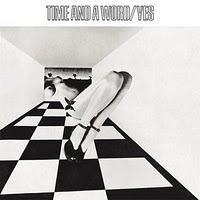 1970s Time And A Word is one of the greatest first-generation Progressive Rock albums, and a wonderful musical snapshot of a young and unsettled Yes that hadn’t quite yet settled into their later Prog Godhood role. Only two-thirds of the “classic” Yes lineup is here, Jon Anderson at Frotman, and the wondrous Chris Squire at Bass and Bill Bruford at Drums. Otherwise it’s part-time Yes man Tony Kaye on Keyboards and Yes’s original (And quite substandard compared to Steve Howe) Guitarist Peter Banks. Still Time And A Word is a wonderful solid album with some truly amazing songs hidden in it’s grooves. The title track is, in my opinion, the most gorgeously beautiful song Yes ever created. And No Opportunity Necessary No Experience Needed is simply thrilling. If you are a fan of Yes, or Progressive Rock you need Time And A Word. –Karl
1970s Time And A Word is one of the greatest first-generation Progressive Rock albums, and a wonderful musical snapshot of a young and unsettled Yes that hadn’t quite yet settled into their later Prog Godhood role. Only two-thirds of the “classic” Yes lineup is here, Jon Anderson at Frotman, and the wondrous Chris Squire at Bass and Bill Bruford at Drums. Otherwise it’s part-time Yes man Tony Kaye on Keyboards and Yes’s original (And quite substandard compared to Steve Howe) Guitarist Peter Banks. Still Time And A Word is a wonderful solid album with some truly amazing songs hidden in it’s grooves. The title track is, in my opinion, the most gorgeously beautiful song Yes ever created. And No Opportunity Necessary No Experience Needed is simply thrilling. If you are a fan of Yes, or Progressive Rock you need Time And A Word. –Karl
Van Morrison “Astral Weeks” (1968)
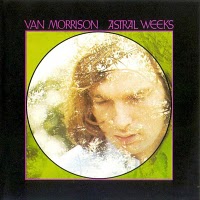 “If I ventured in the slipstream, between the viaducts of your dream…” and so opens the poetic dream masterpiece, Van Morrison’s “Astral Weeks.” It’s one of those monuments to human emotion that has the power to carry the weight of your life with it. The funny thing is, I really wasn’t feeling Van for the longest time, always shelving him away in the “mom-rock” bin. Then all of a sudden something hit me and quickly snowballed into the realization of his genius. With Astral I find the strength lies in the fact that, although the production is both classical and traditional in instrumentation, the record comes across as highly psychedelic from the mysticism of the arrangements. It’s similar in that way to the first few Leonard Cohen records or Townes Van Zandt’s “Our Mother the Mountain,” And for being such a contender among quality poetic-psyche LP’s, it’s easily available and usually pretty cheap, so there’s no reason why you can’t check it out. –Alex
“If I ventured in the slipstream, between the viaducts of your dream…” and so opens the poetic dream masterpiece, Van Morrison’s “Astral Weeks.” It’s one of those monuments to human emotion that has the power to carry the weight of your life with it. The funny thing is, I really wasn’t feeling Van for the longest time, always shelving him away in the “mom-rock” bin. Then all of a sudden something hit me and quickly snowballed into the realization of his genius. With Astral I find the strength lies in the fact that, although the production is both classical and traditional in instrumentation, the record comes across as highly psychedelic from the mysticism of the arrangements. It’s similar in that way to the first few Leonard Cohen records or Townes Van Zandt’s “Our Mother the Mountain,” And for being such a contender among quality poetic-psyche LP’s, it’s easily available and usually pretty cheap, so there’s no reason why you can’t check it out. –Alex
Charles Wright and the Watts 103rd St. Rhythm Band “Express Yourself” (1970)
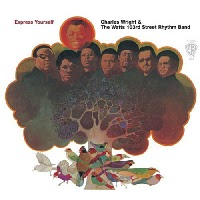 Somewhere between the funk formalism of James Brown and free-spiritedness of Sly Stone can be found Charles Wright. In a perfect world, this enormous talent would be mentioned in the same breath as Redding, Gaye, and Green, but Wright’s long-term success was hobbled by the line-up changes of his various backing bands, inconsistent records, and other music biz unpleasantries. Though he recorded lots of great music–even his weakest efforts are at least worth hearing–this record is his best. Its title track is its most famous (and most sampled), but other tracks like “I Got Love” and the free-form funk freakout, “High as Apple Pie parts 1 & 2”, give it a gospel-like sense of joy. Few reissued records have caused as much confusion as this one. The original release kicked off with a tight little number called “A Road Without End”. Future pressings, however, replaced that track with “Love Land”, which appeared on his previous LP, In the Jungle Babe. “Love Land” is a great song in its own right, but it doesn’t suit the feel of Express Yourself as well as the track it replaces. For this reason, an original pressing of the record is well-worth tracking down. –Richard P
Somewhere between the funk formalism of James Brown and free-spiritedness of Sly Stone can be found Charles Wright. In a perfect world, this enormous talent would be mentioned in the same breath as Redding, Gaye, and Green, but Wright’s long-term success was hobbled by the line-up changes of his various backing bands, inconsistent records, and other music biz unpleasantries. Though he recorded lots of great music–even his weakest efforts are at least worth hearing–this record is his best. Its title track is its most famous (and most sampled), but other tracks like “I Got Love” and the free-form funk freakout, “High as Apple Pie parts 1 & 2”, give it a gospel-like sense of joy. Few reissued records have caused as much confusion as this one. The original release kicked off with a tight little number called “A Road Without End”. Future pressings, however, replaced that track with “Love Land”, which appeared on his previous LP, In the Jungle Babe. “Love Land” is a great song in its own right, but it doesn’t suit the feel of Express Yourself as well as the track it replaces. For this reason, an original pressing of the record is well-worth tracking down. –Richard P
Back “Sea Change” (2002)
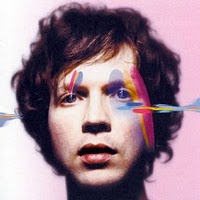 Covering The Zombies, John Martyn, and Nick Drake during his sessions and tour of Sea change, Beck’s influences are ly heard and channeled this time around. While Mutations was all over the place, here Beck works on a very focused playing ground yet stretching some songs to the limit like the bare “Paper Tiger” or very solemn “It’s All in Your Mind”. His voice reaches such a level of power and beauty that could never have been foreseen coming from Mr.MTV Makes Me Wanna Smoke Crack, especially in the country tinged “Guess I’m Doing Fine”. There is just such a chilling yet peaceful tone to Beck’s voice and overall melodies that fully captures what the man must’ve felt to put out such an unpredictable yet honest record.
Covering The Zombies, John Martyn, and Nick Drake during his sessions and tour of Sea change, Beck’s influences are ly heard and channeled this time around. While Mutations was all over the place, here Beck works on a very focused playing ground yet stretching some songs to the limit like the bare “Paper Tiger” or very solemn “It’s All in Your Mind”. His voice reaches such a level of power and beauty that could never have been foreseen coming from Mr.MTV Makes Me Wanna Smoke Crack, especially in the country tinged “Guess I’m Doing Fine”. There is just such a chilling yet peaceful tone to Beck’s voice and overall melodies that fully captures what the man must’ve felt to put out such an unpredictable yet honest record.
Beck has always channeled his place in life and views throughout his albums, whether people could see it through his bizzare language and theatrics is something less debatable. Mutations was his Moon & Antarctica (read: Hopeless, disenchanted sad sack record) but you would have never known, but here we see the most straightforward lyricism yet from Beck. The bitterness (“Is that what you thought love was for?”), the one sided love (“I can’t cry them anymore/I can’t think of what they’re for”), and hopeful hopelessness (“Let it pass on the side of the road/What a friend could tell me now”); Everything here is easy to read into yet nonetheless powerful or mysterious.
As much of a downer Sea Change was in 2002, it gave me a real sense that Beck went on this sorrowful, soul-draining spiritual journey so I wouldn’t have to. It was quite the opposite but Sea Change turned out to become one of the best friends I’ve had. Life’s turned out to be less of my own private award show of Mr. Holland’s Opus and more of a grim train ride passing by everyone I’ve hurt and everyone that’s failed to see how I’ve helped them. I guess I’m at the “Already Dead” part of my life working up to “Side of the Road”, so it makes sense that the 2nd half of the album has began to click with me. It’s also has begun to make sense how strangely beautiful the most awful moments of your life can be, especially when Sea Change is your soundtrack. –Allistair
Fleetwood Mac “Tusk” (1979)
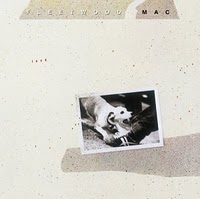 I believe that the true power in this world is love. There’s obviously a strong universal relation to the longing of the soul. I also believe that Fleetwood Mac just might be the best musical representation of love. I could probably write about any Mac record, making similar points, TUSK just happens to be living on my turntable at the moment. It’s not a perfect album by any means, but when you dive deep into this band, it all hits the spot. TUSK is the double-LP follow up to their multi-platinum break up monster, Rumors. Of course there’s no way Tusk could ever have been nearly as much of a commercial success, but that’s what’s nice about it for me, there’s at least one full-length records worth of killer pop “anti” hits that still satisfy the listener in the same way, beautiful vocal coloring over lindsey buckingham’s percussive strumming and driven home by that wonderful snare crack that mick fleetwood perfected in the pop years. Plus this seems to be the point where Buckingham really took over the production and, for lack of a better term, went insane. So the arrangements are wacky as hell at some points and he must have played at least 50 different stringed instruments on it, but what’s love without craziness? Give this a chance if you haven’t already. For lovers only. –Alex
I believe that the true power in this world is love. There’s obviously a strong universal relation to the longing of the soul. I also believe that Fleetwood Mac just might be the best musical representation of love. I could probably write about any Mac record, making similar points, TUSK just happens to be living on my turntable at the moment. It’s not a perfect album by any means, but when you dive deep into this band, it all hits the spot. TUSK is the double-LP follow up to their multi-platinum break up monster, Rumors. Of course there’s no way Tusk could ever have been nearly as much of a commercial success, but that’s what’s nice about it for me, there’s at least one full-length records worth of killer pop “anti” hits that still satisfy the listener in the same way, beautiful vocal coloring over lindsey buckingham’s percussive strumming and driven home by that wonderful snare crack that mick fleetwood perfected in the pop years. Plus this seems to be the point where Buckingham really took over the production and, for lack of a better term, went insane. So the arrangements are wacky as hell at some points and he must have played at least 50 different stringed instruments on it, but what’s love without craziness? Give this a chance if you haven’t already. For lovers only. –Alex
King Crimson “Red” (1974)
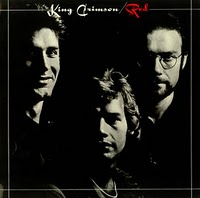 A caged beast of a record, and easily this group’s best, it strips away most of their obscurantist pretensions to serve up a guitar bass and drum assault that runs frequently into the red and is something to behold: Bruford’s drumming is jaw-dropping, while Fripp plays with a dark metallic intensity that suggests he’s one of rock’s wasted talents. I can even put up with John Wetton here, whose ferocious bass playing is more like a second (maybe third) lead instrument and whose singing has a kind of macho bravura that suits this music’s seething intensity. Still, the beast is caged. I’m always a little let down by the second side, which is what keeps Red from essentially essential status, with the wandering “Providence” (another crack at the improv-based excursions heard on the previous album) and the somewhat undercooked “Starless.” No, I’m not kidding: “Starless,” which many listeners seem to think is a masterpiece, could’ve used a little more work. I’m forever disappointed by the whole trajectory of this track, which at 12-some minutes would’ve benefited from a few more (the majestic ending should’ve been lengthier, to provide a kind of bookend equivalent to the sturm-und-drang of “Red;” it may be quibbling, but it’s my party and I’ll cry if I want to). So, instead of the Godzilla of prog-rock tracks, “Starless” is merely a woolly mammoth. This group never made the great record they should’ve made. This one’s the only one that comes close. And oh so close. –Will
A caged beast of a record, and easily this group’s best, it strips away most of their obscurantist pretensions to serve up a guitar bass and drum assault that runs frequently into the red and is something to behold: Bruford’s drumming is jaw-dropping, while Fripp plays with a dark metallic intensity that suggests he’s one of rock’s wasted talents. I can even put up with John Wetton here, whose ferocious bass playing is more like a second (maybe third) lead instrument and whose singing has a kind of macho bravura that suits this music’s seething intensity. Still, the beast is caged. I’m always a little let down by the second side, which is what keeps Red from essentially essential status, with the wandering “Providence” (another crack at the improv-based excursions heard on the previous album) and the somewhat undercooked “Starless.” No, I’m not kidding: “Starless,” which many listeners seem to think is a masterpiece, could’ve used a little more work. I’m forever disappointed by the whole trajectory of this track, which at 12-some minutes would’ve benefited from a few more (the majestic ending should’ve been lengthier, to provide a kind of bookend equivalent to the sturm-und-drang of “Red;” it may be quibbling, but it’s my party and I’ll cry if I want to). So, instead of the Godzilla of prog-rock tracks, “Starless” is merely a woolly mammoth. This group never made the great record they should’ve made. This one’s the only one that comes close. And oh so close. –Will


